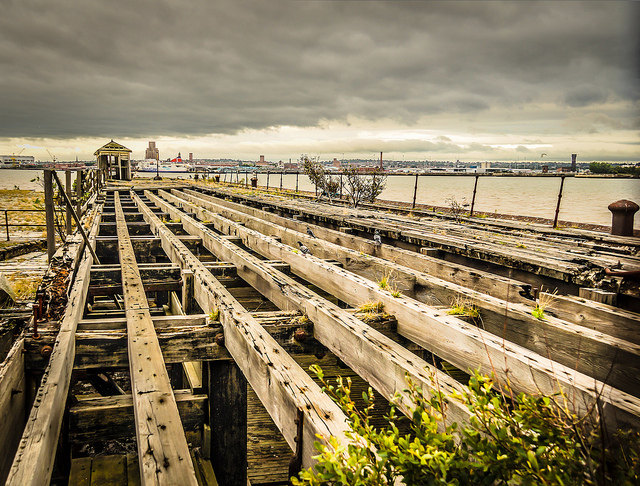“Safe seats” are only really safe as long as rival political parties neglect to target them
Are so called “safe seats” safe because of the devotion of their electors to a particular political party, or because the other parties simply don’t bother wasting their resources on ‘unwinnable’ contests? Alun Wyburn-Powell points to several examples, both historical and recent, which suggest that an intimidatingly large majority may be more fragile than it looks, provided that efforts are made to contest the seat.

Liverpool Riverside, a safe Labour seat with low turnout (Credit: CC BY 2.0)
In election campaigns parties traditionally don’t ‘waste’ their efforts attacking other parties’ ‘safe seats’. At first sight this seems entirely logical – surely it is easier to capture a seat from an opponent who only has a small majority. However, in marginal seats MPs are alert to the danger of defeat. They tend to campaign fiercely and receive extra support from head office. These seats are well-defended. On the other hand, ‘safe’ seats often have less-active MPs and the constituency party machines will not be geared up for intensive campaigning. Complacency often sets in. Safe seats are usually not well-defended and therefore not necessarily that safe, if they are actually attacked.
Anyway, how many seats can each party really rely on? Since the formation of the first Labour government in 1924, there are only around 40 seats which have been continuously held by Labour and no seats which have been continuously held by the Liberals/Liberal Democrats.
On the face of it, the Conservative Party has had the most to feel secure about in terms of safe seats. Around 80 Conservative-held seats have not changed hands since 1924 and some of these seats have looked very safe. In 1931 the leading Conservative candidate in Brighton (which was then a two-member constituency) had a majority of more than 62,000 votes over Labour. The constituency is now divided into two. Brighton Pavilion is now held by the Green Party and Brighton Kemptown was held by Labour from 1997 to 2010. In 1997 the Conservatives lost half of all their seats, being reduced to only 165. Even then, at the next election in 2001 the party lost 8 of these (although they gained 9 others).
When they have come under attack, some ‘safe’ seats have proved to be surprisingly vulnerable. The Labour Party lost Blaenau Gwent (Labour majority over 30,000 in 1992) after a local dispute over candidates. The Conservatives lost Tatton (now George Osborne’s seat) to the Independent MP Martin Bell in 1997 after sitting Conservative MP Neil Hamilton was embroiled in a scandal. In the same election Michael Portillo lost his seat at Enfield Southgate where he had a majority of 15,563. At the 2010 election the Lib Dems lost their most reliably-held seat at Montgomeryshire, but captured Redcar which had had a Labour majority of over 21,000 as recently as 1997.
By-elections have shown the fullest extent of people’s willingness to upset the notions of safe seats, with swings of 44.2% to the Lib Dems from Labour in Bermondsey in 1983, just topping Douglas Carswell’s 44.1% swing from the Conservatives to UKIP in Clacton last week.
So, the number of really safe seats is actually rather less than it seems and there are several reasons why seats are becoming less safe.
Many voters only vote occasionally. Turnout in the 2001 general election was under 60%, but the Scottish independence referendum excited 85% of the voters to turn out. Even then some of the remaining 15% may not have voted because they were undecided rather than not interested. General elections have attracted similar levels of turnout, reaching 84% in 1950. An increase from under 60% to over 80% in turnout would bring around 9 million extra voters into play and they may not vote along the same lines as the regular voters. This could particularly affect seats where turnout has traditionally been low – especially in some urban Labour-held seats, such as Liverpool Riverside where only 34% of voters turned out in the 2001 general election.
As turnout increases, some people who do not usually vote may be attracted and influenced by partial, random or inaccurate information about the choices on offer. A voter in Clacton reportedly voted for the UKIP candidate in last week’s by-election because the old Tory MP had ‘done nothing’ for the constituency. The old Tory MP and the UKIP candidate were, of course, the same person, Douglas Carswell. Reseach by YouGov found that only 20% of voters were even aware that the political parties had recently held conferences, let alone knew anything about what had happened at them. An increasingly diverse range of on-line sources and a decline in national and local newspaper readership means that overall assumptions about voters’ levels of information are dangerous.
Then there is the issue of voter turnover. The electorate is not static between elections. Voters die, move house and new voters reach the age of 18. Most constituencies’ electorates change by about 10% between elections because of this.
Multi-party politics produces new challengers. Particularly the SNP for Labour in Scotland and UKIP for the Conservatives in rural England and Labour in urban seats in northern England. The broadening choice of parties increases the opportunity for tactical voting. With two parties it did not really exist. With three, it was usually the Liberals/Lib Dems who benefited from tactical votes. With four, five or six parties, the opportunities are multiplied. There was evidence of tactical voting both for and against UKIP in the Newark by-election.
A voter may choose to vote according to local circumstances. Imagine a liberal-inclined, environmentally-concerned voter, who is strongly in favour of keeping the United Kingdom intact and remaining in Europe. In a LibDem-held seat, like Cambridge for example, that voter would probably vote Lib Dem. But the same voter, if they lived in Rochester, might vote Conservative as a tactical anti-UKIP vote, but Green if they lived in Brighton and Labour if they lived in Scotland in a Labour-held seat where the SNP were the main challengers – same voter, same priorities, but entirely different voting inclinations depending on the local circumstances.
All of these factors suggest that British politics is likely to become more volatile. However, although there may be significant churn in voter behaviour, all the cross-currents may more or less cancel each other out. For instance, between the general elections of 1997 and 2001, when Labour was returned with a large majority in both contests, over a third of voters acted differently in the two elections, but the transfers roughly cancelled each other out.
The future seems to offer far fewer safe seats for any of the parties, but this may not necessarily lead to a dramatic change in the result. But, all parties need to remember that safe seats are only really safe as long as no-one attacks them.
—
Note: this post is an extended version of this piece on Dr. Wyburn-Powell’s website. It represents the views of the author and not those of Democratic Audit or the LSE. Please read our comments policy before posting.
—
 Dr Alun Wyburn-Powell is currently writing a biography of William Wedgwood Benn, first Viscount Stansgate. He can be found on Twitter @liberalhistory and writes a blog.
Dr Alun Wyburn-Powell is currently writing a biography of William Wedgwood Benn, first Viscount Stansgate. He can be found on Twitter @liberalhistory and writes a blog.





 Democratic Audit's core funding is provided by the Joseph Rowntree Charitable Trust. Additional funding is provided by the London School of Economics.
Democratic Audit's core funding is provided by the Joseph Rowntree Charitable Trust. Additional funding is provided by the London School of Economics.
[…] https://www.democraticaudit.com/?p=8673 […]
Around 40 constituencies have been continuously held by Labour since 1924, reports @liberalhistory: https://t.co/QiBZJrQiQQ
I may be alone in this, but getting exited about the election and this good article on safe seats https://t.co/BfpvelkBr7
Interesting. Since 1924, only c.40 seats always Lab, 0 seats always Libs/LDs & c.80 always Con https://t.co/nHe71cQ7Pf by @liberalhistory
How safe is a ‘safe seat’ in the House of Commons these days? https://t.co/CfeUoRHMGV
RT @COLFEShistory: Fascinating article on the historic safeness or otherwise of “safe seats” by @liberalhistory https://t.co/f9qerOv1m4 http…
Are ‘safe seats’ in the Commons only safe as long as the other parties don’t attack them? https://t.co/CfeUoRHMGV
Just how safe are the ‘safe seats’ in the House of Commons? https://t.co/CfeUoRHMGV
Have the major political parties fooled themselves that some seats are completely safe? https://t.co/CfeUoRHMGV
“Safe seats” – only safe if rival political parties neglect them https://t.co/DLW6yis7j6
We need to get working for GE2015! #YesAlliance
RT @LSEPubAffairs: “Safe seats” are only really safe as long as rival political parties neglect to target them https://t.co/P2NE5nTROU http:…
RT @liberalhistory: Are ‘safe seats’ only safe if no-one attacks them? https://t.co/CfeUoRHMGV
RT @democraticaudit: “Safe seats” are only really safe as long as rival political parties neglect to target them https://t.co/JNf9MAQfaX
“Safe seats” are only really safe as long as rival political parties neglect to target them https://t.co/6zXTeKm89R
“Safe seats” are only really safe as long as rival political parties neglect to target them https://t.co/sQ8IRXAxOM
“@LSEPubAffairs: “Safe seats” only really safe as long as rival political parti…https://t.co/RMBLhaOFXj https://t.co/x6WuBo3TI7” #goodreads